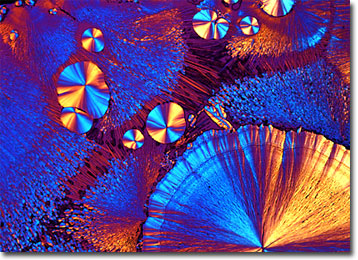Polarized Light Microscopy Digital Image Gallery
Pantothenic Acid
Pantothenic acid is a B-complex vitamin that was discovered in 1919 and first isolated in 1933 by Dr. R. J. Williams. The name of the substance derives from the Greek word pantothen, which means “from everywhere,” a telling reference to its wide distribution.

Essential for animal metabolism, pantothenic acid plays a variety of roles within the body. It is, for instance, a basic component of coenzyme A and is involved in the decarboxylation of pyruvate in the citric acid cycle. The vitamin is also necessary for the bodily production of red blood cells and steroid metabolism, as well as the stimulation of antibody synthesis and proper neuron activity. Some of the many dietary sources of pantothenic acid include yogurt, mushrooms, eggs, lentils, meats, soybeans, and wheat germ. Due to its prevalence in nature, deficiencies of the vitamin are extremely rare. When they do occur, however, it is typically as an unwelcome side effect of another pharmaceutical.
In addition to the natural abundance of pantothenic acid, a synthetic form of the water-soluble vitamin is also available. Marketed as a calcium salt in the industrial sector, the substance is frequently utilized in manufacturing plants and organic chemical processes. Pantothenic acid is also an important nutrient constituent of animal feeds and many human vitamin supplements. As a component of cosmetics products, pantothenate, which is an ester of pantothenic acid usually marketed as vitamin B5, is believed to help slow the aging process of the skin and prevent wrinkling.
